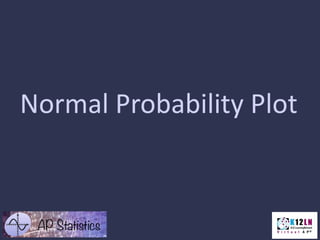Normal Probability Plot - Assess Normal Model Fit
•
0 gostou•921 visualizações
A normal probability plot provides an assessment of whether a normal distribution model fits a data set well. It involves arranging data from smallest to largest, finding the percentile and z-score for each value, and plotting the data points against their z-scores. The closer the plot forms a straight line, the better the normal model fits the data.
Denunciar
Compartilhar
Denunciar
Compartilhar
Baixar para ler offline

Mais conteúdo relacionado
Mais de Ulster BOCES
Mais de Ulster BOCES (20)
Normal Probability Plot - Assess Normal Model Fit
- 2. Normal Probability Plot •Normal Probability Plot - provides a good assessment for using the Normal model on a set of data •Arrange data from smallest to largest •Record the percentile of the data for each value •Use the Normal Distribution table to find the z-scores •Plot each data point (x) against its z-score •The straighter the line, the better fit the Normal model is
- 3. Video of Normal Probability Plot View the TI-Nspire video of how to construct a Normal Probability